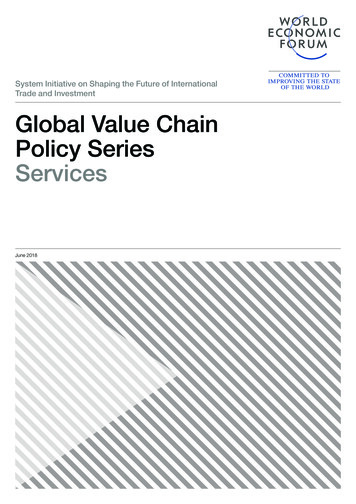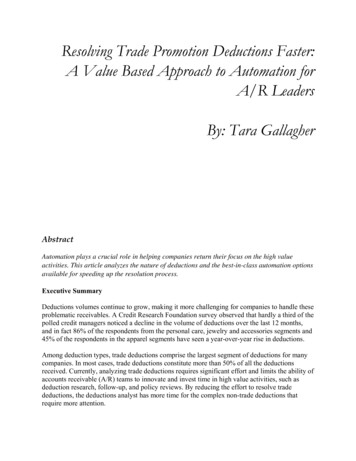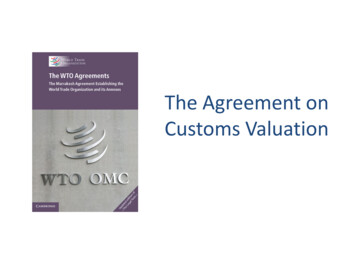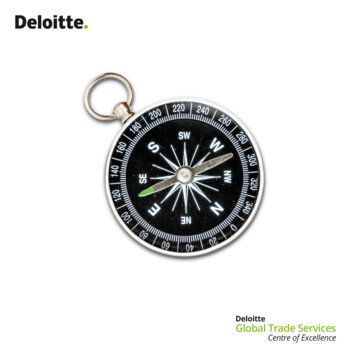
Transcription
System Initiative on Shaping the Future of InternationalTrade and InvestmentGlobal Value ChainPolicy SeriesServicesJune 2018
Author:Jane Drake-Brockman, President, Australian Services Roundtable andProfessor, Institute for International Trade, University of AdelaideReviewers:Vasuki Shastry, Global Head of Public Affairs and Sustainability, StandardCharteredElsa Amouzgar, Vice-President and General Manager of Global Sales,ManpowerGroupThe Global Value Chain Policy Series was launched in 2018 by the World Economic Forum’s SystemInitiative on Shaping the Future of International Trade and Investment. It consists of brief policy paperson various aspects of global value chains (GVCs). The aim of the series is to stimulate cross-policydiscussion and thinking about GVCs and collect ideas from researchers and practitioners on howto help GVCs contribute towards development, sustainability and inclusiveness. These ideas canthen be examined in more depth in the context of particular value chains, regions or public-privateinitiatives. The World Economic Forum is working to bring the relevant actors together to facilitate thismultistakeholder, cross-policy undertaking, aimed at catalysing partnerships for impact.World Economic Forum 2018 – All rights reserved.No part of this publication may be reproduced orTransmitted in any form or by any means, includingPhotocopying and recording, or by any information Storageand retrieval system.REF 020518This white paper has been published by the World Economic Forum as a contribution to a project,insight area or interaction. The findings, interpretations and conclusions expressed herein area result of a collaborative process facilitated and endorsed by the World Economic Forum, butwhose results do not necessarily represent the views of the World Economic Forum, nor theentirety of its Members, Partners or other stakeholders.
Contents4The internationalization of services7Digitalization: “Data” as an intermediate input8Micro, small and medium-sized enterprises9Development dimensions11Sustainability12Gender equality14Policy and regulatory prioritiesGlobal Value Chain Policy Series: Services3
The internationalization of servicesBar a few early commentators on trends in intra-industrytrade and then the global value chain (GVC) phenomenon,the trade policy community was remarkably slow to noticethat, for at least the past three decades, business-tobusiness (B2B) trade in intermediates has accountedfor more than half of global merchandise trade. Thisphenomenon, based on the corporate search for efficient,specialized production locations for each task in the industryvalue chain and underpinned by outward foreign directinvestment (FDI) and contract offshoring, is a manifestationof the process generally known as globalization.The trade policy community took even longer to notice thesame trend under way in services trade. Typically, services,including information and communications technology, wereacknowledged for the enabling role they play in cross-bordermanufacturing value chains. These value chains simplycould not function without efficient international transport,financial transactions or B2B communications providingthe necessary “glue” at each link between the geographiclocations in the chain. New services technologies and someopening in international services markets were recognizedas having reduced the cost of trading in goods, facilitatingthe GVC phenomenon.Box 1: Services in manufacturing GVCsA recent case study in Thailand of a local subsidiary of aglobal leader in bespoke automated welding equipmentand customized in situ welding services (a tier-2 supplierinto other manufacturing processes) revealed 38 servicesalong that company’s slice of the value chain, 25 of whichwere outsourced.One example of outsourcing is international freighthandling. Importing components from Malaysia, forexample, requires coordination of multiple transportstages with customs procedures and related delays.Efficiency is achieved by using logistics providers whocan simply guarantee delivery.Core competence services, on the other hand, tendto be retained in-house – for example, scientific andengineering research and development and testing andlegal support for intellectual property protection.Source: Haines, William, “Industrial Welding Services in Thailand”, inServices in Global Value Chains: Manufacturing-related Services, editedby Low, Patrick and Gloria O. Pasadilla, APEC Policy Support Unit, 6679, 2015.4Global Value Chain Policy Series: ServicesIt took longer for the global trade policy community torecognize that services play much more than this “support”role in goods value chains.At the end of 2012, the joint Organisation for EconomicCo-operation and Development (OECD) – World TradeOrganization (WTO) Made in the World statistical series,based on Trade in Value Added (TiVA) data, shed timelynew light on the full role of services in GVCs. The share ofservices in global exports doubled when measured in thismanner, from an average 23% in balance-of-paymentsterms in 2008 to 45% in TiVA terms.1 Services industryinputs could now be seen to provide an “unexpectedly”high percentage of value added in all merchandise exports,with the percentage of value added increasing markedly themore highly transformed the manufactured item.The fact that this result was received as unexpected, whenservices industries everywhere now account for more than50% of GDP (when construction services and the “utilities”such as energy and water are included), was testament to ageneral lack of understanding and focus on services in theliterature, including the widespread assumption that serviceswere low value-added activities.In addition to all their other inputs along the goods valuechain, services became recognized as providing very highvalue-added, both upstream at the beginning of the goodsGVC (ideation and innovation) and downstream at the endof the GVC (logistics, network orchestration and after-salesservices). Indeed, many “goods” firms had already, in effect,transformed into “services” firms: IBM, for example, sold theThinkpad in 2005 and shifted out of hardware into softwareand services.These new insights on the role of services brought homethe realization, from a policy perspective, that domesticefficiency in the services industries clearly mattered forcompetitiveness, and for export, in every other industrysector and in all economies, developed and developing.The drivers of competitiveness in services were suddenlyunderstood to matter for the whole economy and todeserve more dedicated policy attention. The result ofmuch business case study and other global evidence, thekey driving factors are summarized in Box 2. All of theseare essentially endogenous; i.e., they can be influenced bygovernment policy and regulatory settings.
Box 2: Enabling factors for services competitiveness–– Human capital (talent, education, skills, ideas)–– Investment in intangible assets (corporate intellectualproperty, including business methods) and supportiveenvironment for collaborative innovation–– Enabling digital infrastructure (access to fast reliablemobile broadband)–– Quality institutions (independence, simplicity, flexibility)and efficient domestic regulation (low compliancecosts, allowing flexibility to adapt to change)–– Connectedness with international markets (trade andinvestment reform, openness to cross-border dataflows, availability of visas, international standards,mutual recognition and other forms of cooperationon domestic regulation for seamless cross-borderinteroperability)–– Organized services business advocacy and publicprivate stakeholder consultation–– Deliberate national policy focus (statisticalmeasurement, interagency coordination,competitiveness roadmaps)Source: Drake-Brockman, Jane and Sherry Stephenson, “Implicationsfor 21st-Century Trade and Development of the Emergence ofServices Value Chains”, International Centre for Trade and SustainableDevelopment (ICTSD), 2012.Inter-governmental organizations have made recent effortsto better assist governments with self-assessment ofcompetitiveness in services against these kinds of keycriteria. The World Bank “Valuing Competitiveness inServices” toolkit has set the essential benchmarks.2 Intergovernmental rule-making efforts, including in the WTO,have focused recently, but still without result, on the needfor principles for domestic regulation in services.To continue the storyline, what still tended to go unnoticedfor a very long time was the fact that the services industriesthemselves were globalizing – fragmenting into cross-bordervalue chains. The process admittedly started later and wasslow to get off the ground.One reason behind the relatively slow early pace of servicesinternationalization was the extent of public ownershipacross the sector (telecommunications, banking, transport,infrastructure construction, postal, energy, water andwaste management and distribution, education and health,etc.) and the appropriate sequencing of structural reformssuch that, for competition policy reasons, the process ofprivatization often needed to precede internationalization.Box 3: Domestic regulation is a big services tradeirritantIt is worth illustrating the importance of harmonization ormutual recognition in domestic regulations for servicesexport competitiveness. In the Thai case study discussedearlier (Box 1), trade policy problems identified by thefirm relate especially to regulation of temporary labourmovement. Foreign services providers must obtain a workpermit and a non-immigrant visa, requiring submission of11 supporting documents. The application is processedslowly and ultimately awarded on a discretionary basis.The number of foreign workers a firm may hire is linked toits registered paid-up capital, tax payments and numberof local workers employed. A 10:1 ratio between foreignand local workers is needed. Even when the formalrequirements are met, the visas may not be granted aswelding is considered a protected sector.This makes it impossible to bring in trained techniciansfrom other group members to meet sudden demand.The firm cannot outsource such work to local techniciansnot trained in the use of its equipment. Few other localfirms have the specialized skills required, so the increasein demand tends to go unmet rather than local weldersbeing employed to meet it. In a recent government policyconsultation, the firm involved highlighted this issue as itsprimary obstacle to local expansion.Regional expansion is made doubly difficult becauseneighbouring economies do not recognize Thaigovernment-issued licences or safety inspections.The domestic licensing process is onerous (includingprofessional exams, occupational health and safetytraining and equipment audit) and a significantopportunity cost to the firm. The firm cannot afford tosend its welders and equipment to repeat the licensingand occupational health and safety processes in otherjurisdictions, severely limiting its opportunity to export.Internationally consistent industrial standards plus mutualrecognition of licences and safety training based on thesestandards are regarded by the firm as the policy reformthat would most facilitate international trade.Source: Haines, William, “Industrial Welding Services in Thailand”, inServices in Global Value Chains: Manufacturing-related Services, editedby Low, Patrick and Gloria O. Pasadilla, APEC Policy Support Unit, 6679, 2015.Global Value Chain Policy Series: Services5
Another reason relates to the importance in many servicesof face-to-face services provision and consumption.Traditionally, services providers were constrained by theirinability to capture, store and possess the value of theintangible. There were few opportunities to unbundle thetasks and create step-by-step “pathways” to market. Fora long time, the face-to-face nature and simultaneity ofproduction and consumption of many services hindered anysignificant cross-border activity.It was not until the turn of the century that widespreadapplication of ICT technology meant that knowledgeintensive services could increasingly be “packaged” indigital form, ownership could be established, productioncould be scaled up, units could be stored and exchangedseparately from production via the internet. “Knowledgeintensive business services”, increasingly vital inputs tocompetitiveness in all industry sectors, no longer needed tobe performed in-house and could be unbundled into theirhigher and lower value-added segments.So began the search for lower-cost, more efficientintermediate services production offshore. To some extent,the process of globalization in services mirrored the processin manufacturing. It certainly involved much FDI – to enableprotected technology to flow safely offshore; for example,in the knowledge process outsourcing (KPO) sector andparts of the business process outsourcing (BPO) sector –but it also involved much contract offshoring to servicessmall and medium-sized enterprises (SMEs) and start-upsin developing countries, especially in information technologyoutsourcing (ITO).There is now a constant quest in the services sector tosegment out any business function where the servicesexpertise can be digitalized and traded cross-border via theinternet. The innovative business process transformationvery much involves engaging SMEs, as well as creatingglobally integrated services firms. The outcome is thatservices outsourcing trebled from 2005 to 2010 and ICTenabled business services intermediates have becomeone of the fastest-growing components of world tradetoday.3 So began the services outsourcing and offshoringstory of the “services revolution”, with all its implications forlatecomers to development, explored a little further below.This also generated increased efforts to map servicesbusiness value chains (e.g., by Gereffi and others at DukeUniversity and more recently the Swedish National Boardof Trade,4 the Internatio
27.04.2017 · whose results do not necessarily represent the views of the World Economic Forum, nor the entirety of its Members, Partners or other stakeholders. Author: Jane











